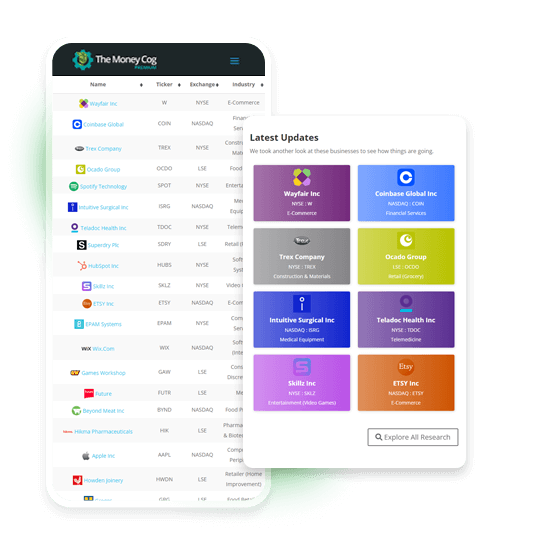Investing in 5G stocks and shares is gaining a lot of popularity as the next-generation communication technology begins to roll out. While 5G deployment actually started back in 2019, it’s only now starting to have a noticeable impact. And analyst forecasts estimate the total number of users, which stood at 10 million two years ago, could reach 1.1 billion by 2023!
Without a doubt, this presents a huge opportunity for individuals thinking about investing in this stock market sector. With that in mind, let’s take a closer look at the 5G technology, the stocks currently leading the charge, and the risks investors ought to know about.
What Are 5G Stocks?
In simple terms, 5G stocks refer to companies that develop and help utilise the fifth generation of telecommunication networks. But what exactly is the 5G network?
The technology is the successor to 4G and features drastically superior speeds and bandwidth capabilities. It delivers higher multi-Gbps peak data speed, with increased reliability, more availability, ultra-low latency, massive network capacity and uniform user experience for more users. That’s quite a mouthful. But in simple terms, it’s much, much faster.
Needless to say, 5G will significantly impact the way we live, work and play. It goes well beyond being able to stream videos in 4K resolution. The technology can power complex communications between different devices, from the Internet of Things to Self-driving cars.
Given the diversity of applications, there are different categories into which 5G stocks and shares can be placed:
- Low-Band – This is also known as the “coverage layer”. It refers to frequencies that are below 1 GHz, which was used to rapidly roll out 5G network signal coverage as quickly as possible. An example is the 600 MHz spectrum deployed by T-mobile US. Other companies that have deployed low-band 5G include AT&T and Nokia.
- Mid-Band – This refers to the businesses using frequencies within the 5G spectrum range of 1GHz and 6 GHz. Mid-band 5G creates a balance between coverage and capacity. T-mobile US has deployed a 2.5 GHz spectrum in its operation. Also, Sprint Corp. deploys a 2.5 GHz spectrum that serves over 16 million users in nine cities in the US. It is noteworthy that most operators use 2.5 GHz GSMA have described the spectrum in the 3.3 GHz to 3.8 GHz range as appealing.
- mmWave High-Band – The last type of 5G deployed by operators is the millimetre wave spectrum. High-band 5G delivers super-fast speeds over short distances. It is within the spectrum of the 24 GHz band and higher. GSMA recommends spectrums within the range of 26 GHz, 40 GHz, 50 GHz and 66 GHz bands for mobile services. According to McKinsey, 5G deployments using a millimetre wave spectrum are expected to cover 25% of the global population by 2030. Verizon, AT&T and T-Mobile US have all rolled out high-band 5G.
- 5G Infrastructure – These are groups that develop the technology needed for the functionality of the fifth-generation networks. 5G requires a network of macro and small-cell base stations with edge computing capabilities to function. Ericsson, Nokia and Qualcomm are arguably the largest players in this part of the industry.
What Are The Main Risks & Challenges Of 5G Shares
The first thing to remember is that investing in stocks has its risks and challenges, and it’s no different for 5G shares. That said, here are some of the largest threats that these businesses are currently facing.
- Public Health Concerns – The deployment of 5G comes with some level of public health concerns. Studies have been carried out to inspect whether these networks operating on such a high frequency have the potential to harm individuals. And the results have largely concluded that there is nothing to worry about. Yet there remains an element of concern for some individuals, and it’s something these businesses will need to address to maximise performance.
- Cost – Establishing the infrastructure needed to deploy 5G solutions is not exactly cheap. The technology requires expensive microcells to operate. And the rising demand combined with restricted supply could quickly send prices higher. That obviously creates a financial barrier that may be difficult to overcome, especially for younger firms.
- Competition – Considering the potential of the 5G network, several companies have ventured into the sector to compete for market share. Investing in 5G stocks that are unable to keep up or overtake their rivals could result in significant negative performance for my portfolio.
- Security Concerns – 5G, like any other telecommunication network, could be vulnerable to cyber-attacks. What makes it more troubling is the severity could be much higher than in the past, given the number of devices that will likely use these networks in the future. This could create significant problems later down the line.
Key Financial Metrics To Watch When Investing In 5G Stocks
Without a doubt, businesses need money to function. But not all companies have sufficient cash flows or access to external capital. And that means the investor needs to check the financial situation of any 5G shares before investing in them. With that in mind, here are some key financial metrics to help investors assess 5G stocks.
- Return on Invested Capital – This ratio helps the investor to know how well a company is able to use its capital to generate profit.
- Operating Margin – Measures how much a company makes from every dollar of sale after removing the cost of production but before paying interest and taxes.
- Debt-to-Equity – This helps the investor to know how much debt a company has in relation to the shareholder’s equity.
- Return on Equity – Reveals how much a company makes from a dollar of a shareholders’ equity that is invested in the company. The higher this ratio, the better.
- Gross margin – This metric shows how much a company retains after removing the cost of goods sold. The higher this number, the better for the company.
Key Terms To Know When Investing In 5G Shares
Every industry has jargon peculiar to it. Below are some key terms to know when investing in 5G stocks.
- 5G – Fifth-generation cellular network technology, it is the successor to the 4G network. It is faster than 4G and also opens the way for IoT technology.
- LTE – Long Term Evolution, a 4G standard technology that sets the way for 5G technology.
- 5G NR – 5G New Radio developed to replace LTE.
- Fixed Wireless – One of the types of 5G services, the other being cellular technology.
- Radio Access Networks (RAN) – Used to connect devices to the various parts of a network through radio connections.
- MIMO – Stands for multiple input, multiple outputs. It is a transmission technology that comprises multiple antennas for communication at their source and destination.
- Small Cell – This term refers to small, low-powered radio frequency base stations that are built to improve wireless network efficiency. Small cells are useful for all types of 5G spectrums.
What Is The Potential Market Size?
According to a report by Allied Market Research, the global 5G Technology Market was valued at $5.13bn at the end of 2020. This figure is expected to reach $797.80bn by 2030 at a 65.8% compounded annual growth rate!
Another study by Grand View Research shows the global 5G System Integration Market is projected to reach $39.57bn by 2028, growing at a CAGR of 25.9% between 2021 and 2028. The same study estimates the global 5G chipset market size to reach $66.45bn by 2028 at a CAGR of 69.1% between 2021 and 2028. Additionally, it projects the global 5G infrastructure market to reach $80.5bn by 2028 at a CAGR of 49.8% from 2021 to 2028.
It is worthy to note that the deployment of 5G in automation, monitoring and tracking, connected vehicle, Virtual and Augmented Reality, Smart surveillance, and smart cities, among others, is expected to drive the explosive growth of the sector.
Top 5G Stocks in the UK by Market Capitalisation
Several 5G stocks are publicly traded. This gives investors a variety of options. That said, here are the top five 5G stocks in the UK in order of market capitalisation.
| Company | Market Cap. | Description |
|---|---|---|
| Vodafone Group (LSE:VOD) | £36.72bn | Provides communication services. |
| BT Group (LSE:BT.A) | £18.59bn | A 5g stock which provides communication products and services. |
| Spirent Communications (LSE:SPT) | £1.42bn | Provides automated test and assurance solutions for networks, cybersecurity, and positioning. |
| XP Power Limited (LSE:XPP) | £635.46m | Designs and manufactures electronic components used in 5G devices. |
| BATM Advanced Communications (LSE:BVC) | £185.38m | Provides real-time technologies for networking solutions |
Top 5G stocks in the US by Market Capitalisation
| Company | Market Cap. | Description |
|---|---|---|
| Broadcom (NASDAQ:AVGO) | $237.38bn | Designs, develops, and supplies various semiconductor devices globally. |
| Verizon Communications (NYSE:VZ) | $213.38bn | One of the leading US telecom stocks which provide communications, technology, information, and entertainment products. |
| Advanced Micro Devices, (NASDAQ: AMD) | $172.26bn | Designs, develops, and supplies various semiconductor devices globally. |
| T-Mobile Us (NASDAQ:TMUS) | $171.25bn | Provides mobile communication services. |
| Qualcomm (NASDAQ:QCOM) | $158.17bn | Develop and commercialise foundational technologies for the wireless industry worldwide. |
Should I Invest In 5G Stocks?
The fifth-generation technology is still at its infant stage. And while that does elevate the risk profile, it also enables early investors to reap the most rewards over the long term. That’s why I’m keen to start investing in the best 5G stocks and shares for the long term.
However, I’m planning to take a diversified approach to my portfolio. And depending on the individual, the high-risk association of these investments are most likely unsuitable for more risk-averse investors.
Discover market-beating stock ideas today. Join our Premium investing service to get instant access to analyst opinions, in-depth research, our Moonshot Opportunities, and more. Learn More
Prosper Ambaka owns shares in Nokia. The Money Cog has published a Premium Report on XP Power Limited. The Money Cog has no position in any of the companies mentioned. Views expressed on the companies and assets mentioned in this article are those of the writer and therefore may differ from the opinions of analysts in The Money Cog Premium services.





